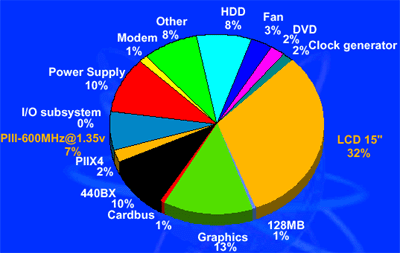S3 SuperSavage MX/IX Mobile 3D Accelerator
by Anand Lal Shimpi on March 14, 2001 3:50 AM EST- Posted in
- GPUs
Power, then Performance, then Features
Recently, there has been increased focus on extending battery life and thus limiting power consumption of individual components in notebooks. Intel conducted some tests that illustrated the power consumption of the various parts of a notebook, and it turns out that in a Pentium III 600 laptop, the graphics subsystem accounts for approximately 13% of the total power consumption of the laptop.

With Intel's release of their Ultra Low Voltage Pentium III 500 CPU, capable of operation at 1.1V consuming less than 1W of power, it's obvious that a 2.8W GeForce2 Go is still too much for the lower power notebooks. And this is where the SuperSavage comes into play. Instead of going after the desktop-replacement mobile market segment which is where the GeForce2 Go is currently targeted, the SuperSavage brings 3D acceleration to the thin and light segment.
S3 knows very well that they are not able to compete on a performance basis with NVIDIA, they realized that very well from competing with them in the desktop market. However in the mobile market, S3 and the OEMs they provide products for have a much different set of priorities: power, performance and then features.
In spite of having a higher clock speed and the ability to apply two textures to a pixel in every clock cycle, the SuperSavage's 0.18-micron process allows it the benefit of drawing approximately the same if not less power than the Savage MX/IX chips it is replacing. This means that the chip consumes around 2W and possibly even less, which is at most 71% of the power usage of the GeForce2 Go.
If the graphics subsystem is estimated at accounting for 13% of the total power consumption in a Pentium III 600 laptop, then this type of savings is definitely tangible.
The SuperSavage does have some other significant improvements in the area of power consumption to keep its efficiency at a maximum. The core features a self-gauging clock technology where the individual portions of the core (e.g. the 2D, 3D, motion compensation, etc… engines) are powered down if they go unused. While this seems like an obvious feature to include, it actually wasn't present on the original mobile Savage parts.
If you'll remember from our discussions around ATI's Radeon Mobility, ATI included a SpeedStep-like function that allows the user to decrease the clock speed of their graphics solution when they are running on battery power or have it run at full speed when the laptop is plugged into the wall outlet. ATI will also allow the flexibility of adjusting the Radeon Mobility's clock speed and thus voltage to virtually any setting desired through a software utility which can also help optimize for battery life.
S3 is considering including similar functionality with their SuperSavage products however they have yet to come to a firm decision on it. It seems to be a simple decision on our side, as the more flexible a solution the easier it is to please the user base out there but then again we're not making the chip so unfortunately the decision does not lay in our hands.
These power characteristics will allow the SuperSavage to be used in thin and light notebooks, meaning those notebooks that are generally 1" in thickness or less and usually make use of Low Voltage Pentium III processors but aren't necessarily sub-notebooks. These notebooks generally feature a 10 - 13" screen and fall in the mid to high range market segment while remaining cautiously below the NVIDIA-zone, the desktop replacement segment.










0 Comments
View All Comments